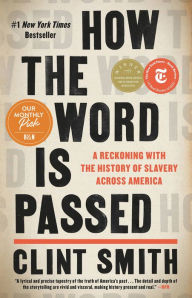Symbols Reflect the Stories We Tell: A Guest Post from Clint Smith, Author of How the Word is Passed
How the Word Is Passed: A Reckoning with the History of Slavery Across America
How the Word Is Passed: A Reckoning with the History of Slavery Across America
By Clint Smith
In Stock Online
Paperback $18.99
A travelogue, a history, a quest, a warning and a call for a reckoning that the history of slavery is the history of our country, central and defining to who we we were and who we are, individually and collectively. In powerfully lyrical prose, Clint Smith challenges us to really learn our history, listen to our legacies, understand the recollections that “remain in the marrow of our bones,” that travel through time and generations. A tour de force that will keep you engaged long past the last page. Keep reading to hear from Smith about what made him decide to write the book and the impact symbols have.
A travelogue, a history, a quest, a warning and a call for a reckoning that the history of slavery is the history of our country, central and defining to who we we were and who we are, individually and collectively. In powerfully lyrical prose, Clint Smith challenges us to really learn our history, listen to our legacies, understand the recollections that “remain in the marrow of our bones,” that travel through time and generations. A tour de force that will keep you engaged long past the last page. Keep reading to hear from Smith about what made him decide to write the book and the impact symbols have.
In May of 2017 three statues of Confederate leaders came down in my hometown of New Orleans—statues of Robert E. Lee, Jefferson Davis, and P.G.T. Beauregard.
As I’m watching these statues come down I thought to myself: What does it mean that I grew up in this majority Black city, in which there are more homages to enslavers than there are to enslaved people? What does it mean that, to get to school, I had to go down Robert E. Lee Boulevard; that, to get to the grocery store, I had to go down Jefferson Davis Parkway; that my middle school was named after a Confederate leader; that my parents live on a street named after someone who enslaved over 150 people? And I wondered what are the implications of that were. Because we know that symbols aren’t just symbols. They are reflective of the stories that people tell, and those stories embed themselves into the narratives that societies carry, and those narratives shape public policy, and public policy shapes the material conditions of people’s lives. This isn’t to say that taking down a statue of Robert E. Lee is going to suddenly erase the racial wealth gap, it’s not to say that taking down monuments is a panacea to issues of racial injustice, but it is to say that this iconography shapes the ecosystem of public consciousness that help people understand why our country looks like it does today.
So, I started thinking about how the history of slavery was memorialized in my own hometown, and then started wondering how it might be memorialized — or not — in museums, monuments, cemeteries, prisons, plantations, and cities across the country. I went on this journey to explore how these different sites — places like Monticello, Angola prison, Whitney Plantation, and New York City — engage with their own respective relationships to this history, and ultimately found different places that reflect the inconsistency with which the history of slavery is remembered across the United States, and abroad.
On a personal level, writing this book felt important to me because when I was a child growing up in New Orleans, I remember being inundated — in ways both explicit and subtle — with messages touting all the things that were wrong with Black people. It was a seemingly endless barrage of pathology wielded to suggest Black people were singularly responsible for the disparities we were experiencing. I remember a feeling of social and emotional paralysis, knowing that what I was hearing was wrong, but not having the language, the toolkit, or the historical framework with which to push back against it.
How the Word Is Passed is my effort to write the sort of book that I felt like I needed when I was in my high school American History class. It is an effort to establish a clearer connection between the past and present. It is an effort to help the younger version of me more fully understand how the legacy of slavery has shaped the way that my city, my state, and my country look the way that they do today.

